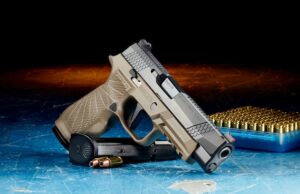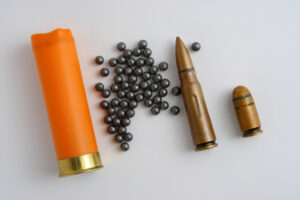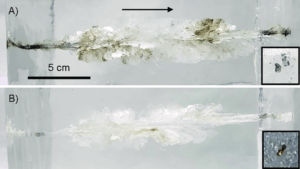Thankfully, I’ve never had a gunshot wound. I’ve treated nail gun injuries and gun shot wounds in the E.R.
None are pretty!
One brief article can’t give you the full story of gunshot wounds—it would take books. This overview will show you how to avoid the most common errors found in print and film, and point you to places to learn more.
ANOTHER FUN QUIZ! (just what you wanted, right?)
- Close examination of the skin will always identify which bullet wound is the entry and which is the exit.
- Bigger, high-caliber bullets cause more damage than low-caliber bullets.
- All bullet wounds should be sutured ASAP to stop further bleeding and prevent infection.
- A handgun bullet can pierce farther into the body and cause more damage than a shotgun wound.
- If not treated promptly, flesh wounds can lead to fatal bleeding.
- Shotgun shell color identifies the gauge of the shot pellets.
- Bullet wounds are categorized as penetrating, perforating or both.
- In non-perforating gunshot wounds to the head, a retained bullet will be found inside the skull half the time.
- Survival from blood loss depends solely on the percentage of blood volume lost.
- Once the heart stops, a victim can’t move.
QUIZ Answers:
- FALSE. Wound skin edges turned, lacerated, or punched inward indicates an entrance wound. Skin around an exit wound looks the opposite—edges turn outward. The problem is the word “always.” Depending on a person’s body type, size, and where the bullet entered/exited, determining entry vs. exit can be difficult.
- TRUE. Larger caliber bullets make bigger holes. High-velocity large caliber bullets cause extreme damage.
- FALSE. Many low-velocity gunshot wounds to the extremities are NOT sutured.
- FALSE. Why my Kentucky aunt always kept a loaded shotgun handy! Close range shotgun blasts are devastating. In fact, a shotgun wound can remove entire chunks of the body. While a handgun bullet penetrates farther and does tremendous damage depending on what it strikes, a single bullet is more like a tornado going through rather than a hurricane of shotgun pellets.
- FALSE. Probably the most common error in books and movies is with flesh wounds. This term means a minor graze, tangential wound, or a superficial through-and-through wound of skin and/or muscle that doesn’t strike anything vital. A flesh wound may still bleed a lot, but it does not cause life-threatening bleeding.
- TRUE. Shotgun shell color identifies the gauge. Federal Ammunition Company came up with a system so a shooter didn’t put the wrong gauge in their shotgun and blow up the barrel. Brown=ten-gauge, red= twelve-gauge, yellow=twenty-gauge, purple=sixteen-gauge. These are not the only shell colors and are not coordinated across manufacturers nor in the military. Look it up unless you know.
- TRUE. Gunshot wounds are described in many ways. Almost all gunshot wounds pierce the skin and penetrate. Perforating means the bullet has also left the body. If a bullet ricochets after exiting and then strikes the victim again, a gunshot wound can be penetrating and perforating. Handgun wounds are categorized by distance from the muzzle as contact, near contact, intermediate, and distant.
- TRUE. In half of fatal gunshot wounds to the head where the bullet doesn’t perforate the body, the bullet will be found inside the skull cavity.
- FALSE. Surviving blood loss is based on many factors, not just the percentage lost.
- TRUE. Some victims can still run several yards before collapsing. It’s hard to believe, but you can function without a heart for a brief time. Just ask Tony Stark.
Bullets that sever a large artery or strike a highly vascular organ (heart, liver, spleen, lung, brain) cause life-threatening bleeding. Share on X
What do writers need to know about gunshot wounds?
Remember: #1 Rule of Thumb with writing about gunshot wounds is: there’s always an exception to the rule! Share on X
- Victims of gunshot wounds DON’T FLY BACKWARDS like in movies and TV. Bullets don’t have enough kinetic force for that. If a victim is already on the move, trying to duck, or trips, you can see body motion. Just being hit by a bullet while standing still will not send you flying through a window. You might stagger back a step or two, and that’s it. A shotgun injury victim might be forced back only a few inches.
- There’s usually a lot of blood at the scene and in the emergency room. I worked in the blood bank during college and delivered blood to the ER. Believe me, a bad GSW causes enormous blood loss.
Damage from a gunshot depends ALL of the following:
-
- Weapon distance to the victim
- Type of bullet (cartridge) or shotgun shell used, size, jacketing (full metal or not) and shape
- Where the bullet strikes—soft tissue, or any vital organs or bone?
- What clothing did the bullet go through, if any?
- Did the bullet hit anything before the victim?
- Gunshot wounds to the head are survivable, but usually are fatal.
- Gunshot wounds to the liver, heart, or spleen cause massive bleeding and threaten life.
- If the bullet strikes the aorta, pulmonary artery or vein in the chest, it’s nearly always fatal.
- An entry wound is slightly smaller in diameter than an exit wound. Even forensic pathologists can have trouble determining entry vs. exit depending on the wound size and state of the corpse when the gunshot occurred. Bullets can ricochet inside the body or rarely re-enter the exit wound. One case involved a bullet that bounced right back through the initial exit wound, which made it look like an entry wound.
- If a bullet severs an artery, bleeding is stopped with direct pressure and/or a tourniquet.
- Antibiotics and surgical exploration are optional except for high-velocity bullet wounds, dirty wounds, or shotgun injuries.
- If low-velocity bullet holes are sutured, oozing can create a pocket of blood and serum—a perfect place for germs to grow. Modern E.R.s use antibiotics to prevent and treat infection.
- When surgery is required, prophylactic antibiotics are used based on the injury site(s).
Victim factors
- Life-threatening blood loss depends on multiple factors, including:
-
- ambient temperature—hypothermia increases bleeding because platelets, which help your blood clot, don’t work as well.
- number of wounds and their location
- body size
- age
- co-morbid conditions or frailty
- whether they take any drugs like a blood thinner or have a bleeding disorder such as hemophilia
- how fast bleeding occurs.
A future post, Writing About Blood Loss, will go into greater detail on this complex issue. Many writers have questions about this.
A fatal gunshot wound can look minor with little visible bleeding because the victim may already be in shock from internal bleeding. Share on XTreatment of a gunshot wound at the scene depends on vital signs—blood pressure and heart rate—and stopping/slowing severe bleeding.
Infection from a gunshot wound is not an immediate concern for first responders—bleeding and shock are. Share on X
- The assassination of President Andrew Garfield in 1881 is a good example of how slow infection can take to develop. Garfield was shot twice. The first bullet grazed a shoulder, but the second one went through his back and ended up lodged behind his pancreas. Garfield did not die until seventy-nine days later of sepsis.
BTW, bullets do not sterilize the wound as medical schools once taught.
- “GSW” was the usual annotation in medical charts before computerized records.
- Be careful about gunpowder versus black powder. Black powder for us Trekkies is what Captain Kirk concocted in the 1967 Gorn episode—or for non-Trekkies a combination of sulfur, charcoal, and potassium nitrate. Black powder is highly explosive. Gunpowder is black powder with other ingredients added. A mere spark can set off black powder. (Why one of my uncle’s friends nearly had a heart attack when we found an open can of black powder on in my uncle’s kitchen after his funeral. I guess he thought it was safe on the top shelf?
- You can find videos of actual gunshots into dummies or gelatin blocks online. (search for “ballistic gel photos”) Many show how movies/ writers get it wrong.
- These videos also help if you want to see what a particular gun and bullet combination will do.
What happens to the body during a Gunshot Wound?
First, know and understand your ammo!
A modern round of ammunition is a combination of things. Bullet refers to the solid piece of a lead metal alloy which comes in a variety of shapes; inside a metal casing, called the brass, even though it may not be made of brass; along with gunpowder; and a primer in the bottom cap, which ignites the gunpowder.
From left to right below are outlines of a shotgun shell, shotgun pellets, rifle round and handgun round.


A bullet does not speed in a straight line through the body. Once it pierces the skin, it starts to wobble, causing more tissue damage inside of the body. Share on X
Many physical forces act on a bullet as it heads toward a victim.
- muzzle velocity – how fast the bullet is going as it leaves the end of the gun barrel
- distance–how far the bullet travels
- air temperature–cold air can affect how a bullet will travel
- gravity–what goes up must come down is still true with bullets
- spin–did the bullet exit a smooth bore or rifled barrel (rifling is the spiral lines carved inside a gun barrel to stabilize the bullet and give it a spin to fly straighter)
- terminal velocity–how fast the bullet is going when it strikes the victim
- yaw—best described as a wobble or wiggle. Bullets don’t fly perfectly straight – they fly fast but still saw back-and-forth motion. Rifle bullets can tumble end over end.
Learn more about ammo rounds here:
https://www.americanfirearms.org/bullet-sizes-types-calibers/
At first, when a bullet strikes, skin briefly resists and stretches before it tears. A bullet can lodge in the skin. If a bullet moves into the body, it creates direct damage along its full pathway.
Any bullet, especially high-velocity ones, causes a temporary cavity–a ballooning of tissue forced outward by kinetic energy around the bullet’s path. The cavity will immediately collapse.
Permanent cavitation injury along the track depends on 1) the type of bullet used and 2) its velocity.
Usually, the temporary cavity will be largest near the initial entrance wound.
These ballistic gel photos show both cavitation and fragmentation.

Leontowich, Adam & Panahifar, Arash & Ostrowski, Ryan. (2022). Fragmentation of hunting bullets observed with synchrotron radiation: Lighting up the source of a lesser-known lead exposure pathway. PLOS ONE. 17. e0271987. 10.1371/journal.pone.0271987. https://creativecommons.org/licenses/by/4.0/legalcode
A direct cavitation injury of three inches in a muscle isn’t life-threatening, unlike the same injury to a vascular organ. The average liver has around one pint (one unit) of blood and the spleen has one cup (200 cc, or a little under ½ unit).
Bullets also cause sonic wave injuries which are devastating to hollow organs such as the intestines, bladder, or a pregnant uterus.
Great article on ballistics with diagrams:
https://webpath.med.utah.edu/TUTORIAL/GUNS/GUNBLST.html
Gunshots to the Brain
Gunshot wounds to the brain can sever large blood vessels inside the brain. Unlike the rest of the body, the brain is encased in a rigid skull. The cavitation force of the bullet or shotgun pellets will expand the brain. That energy has nowhere else to go. The pressure can fracture or split the skull from the inside out.
This is catastrophic, like firing a bullet into a pressure cooker. Victims of gunshots to the head may be unaware of the injury and still function for a while. At first, President Lincoln was not aware he’d been shot.
Brain tissue itself also reacts. It swells, which raises intracranial pressure. Severe swelling pushes the brain in the path of least resistance—toward the large opening at the base of the intact skull called the foramen magnum. The brainstem is the lowest portion of the brain and controls routine vital functions like breathing and heartbeat.
Instant death results when the bottom of the brainstem herniates (gets pushed) down into the foramen magnum.
Gunshots to Bone
Bullet striking bone can lodge, shatter, and/or pass through the other side. Bone can even cause the bullet to ricochet back into the body. Bone fragments can become secondary missiles inside the body.
In one case I’m aware of, a high-velocity bullet ricocheted multiple times inside the chest cavity, bouncing off various ribs, and destroyed the lungs.
A bullet or bullet fragment can travel through large blood vessels (embolize) as the heart is pumping. Bullets and shotgun pellets have been found in the heart and lungs from entry wounds elsewhere. Only shotgun pellets have ever been found embolized to the brain.
Writing About Shotgun Injuries?
Shotguns are a smooth bore weapon unless the barrel is rifled for shooting slugs. Police departments use slugs. Shells contain shot, gunpowder, and a non-explosive material called the wad, along with a load of metal pellets.
Gauge is not based on the cartridge diameter! It’s based on how many balls (shot) of a particular diameter make up a pound of lead. Shot itself can be made of lead, steel, or other alloys. The wad also turns into a missile and can cause injury.
Shotgun barrels have a choke (narrowing) toward the end of the barrel to force the pellets into a smaller grouping.
Birdshot is small and rarely causes fatal injuries. Buckshot and slugs are designed to be lethal.
At close range, the reason a shotgun is more deadly than a handgun bullet is the formula for kinetic energy. The force transferred to the victim depends on the bullet weight and speed. Higher velocity quadruples the amount of force. With shotgun pellets, each individual pellet will travel at a lower velocity than a bullet, but the shell leaves the barrel at close to the same speed as that of a handgun round.
From a few feet away, the total foot/pound force of a shotgun shell can equal that of a high-velocity rifle round.
The kinetic energy of a single high-speed bullet mostly stays with the bullet if it pierces the body but doesn’t fragment. Shotgun pellets distribute in a spray pattern. More pellets create multiple pathways of damage. Pellets also tend to stay in the body, so the kinetic force remains, too.
From seventy-five to two hundred yards away, depending on the gauge and load, the advantage of a shotgun dissipates somewhat because the pellets move slower and disperse too widely to inflict lethal harm.
A bullet transfers its kinetic force from the gun to the victim.
Kinetic force does most of the damage.
Kinetic energy = mass of bullet x velocity2
Handy short guides to the treatment of gunshot wounds:
https://medlineplus.gov/ency/patientinstructions/000737.htm
https://www.mountsinai.org/health-library/selfcare-instructions/gunshot-wounds-aftercare

FYI: Dirty Harry was wrong—his .44 Magnum Smith & Wesson Model 29 would not blow Scorpio’s head clean off.
Now go out there and make my day by correctly writing about gunshots!
Deeper Dive:
https://www.ncbi.nlm.nih.gov/books/NBK564335/ Great summary of abdominal GSW from the National Library of Medicine
If you plan to write many crime stories, I recommend investing in a copy of the most recent edition of Gunshot Wounds: Practical Aspects of Firearms, Ballistics and Forensic Techniques by Vincent J.M. DiMaio. An outstanding, succinct, and well-organized reference guide with photos (so long as you aren’t squeamish) with explanations and diagrams.
Two awesome websites & podcasts run by law enforcement officers I met at Cop Camp 2023:
http://writersdetectivebureau.com
Thanks for reading!

